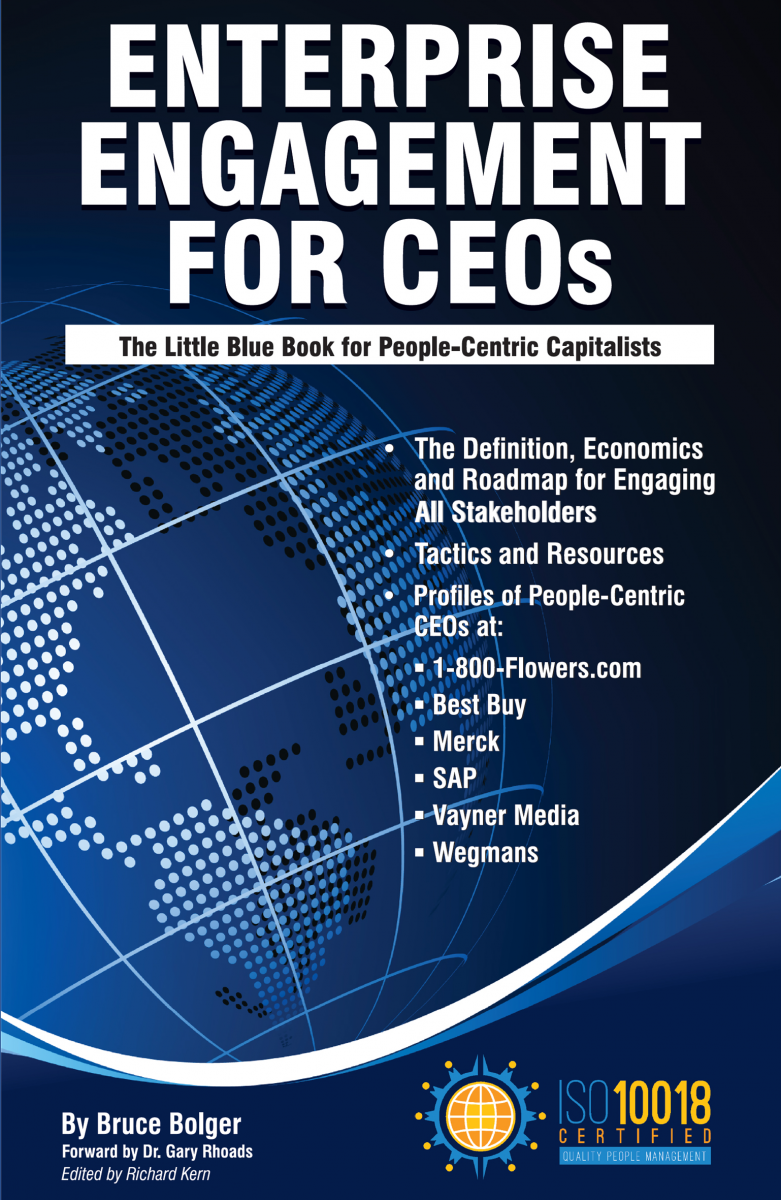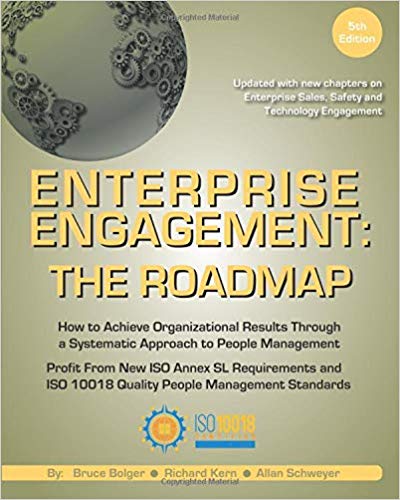Do You Know Your Human Capital ROI? If Not, Your Company May Be Leaving Money on the Table
 If you now believe that there is a link between your human capital—the proactive involvement of all your customers, employees, distribution and supply chain partners, and communities—this quick internal exercise will help you determine if your organization is leaving money on the table and potentially how much. What companies track internally and report externally are usually different based on regulatory requirements and competitive considerations. This process is designed for internal use only and as a means to identifying the best strategy for public disclosures.
If you now believe that there is a link between your human capital—the proactive involvement of all your customers, employees, distribution and supply chain partners, and communities—this quick internal exercise will help you determine if your organization is leaving money on the table and potentially how much. What companies track internally and report externally are usually different based on regulatory requirements and competitive considerations. This process is designed for internal use only and as a means to identifying the best strategy for public disclosures.| Category | Methodologies | Metrics | |
| 1. Leadership | Yes/No |
• The CEO is fully engaged in an enterprise approach to people management and actively leads and/or supports the development of a formal plan with support of the C-suite and other management.
• There is a clear mission statement and values are consistently communicated and rewarded throughout the organization to all stakeholders.
• A review of internal and external communications and recognition would reveal a consistent message aligned across stakeholders.
Score:
|
• The degree to which stakeholders can define the overall mission, vision, and values of the organization in focus groups or surveys.
• Engagement scores of employees related to their managers.
• Turnover; turnover by category.
Score:
|
| 2. Compliance | Yes/No |
• To what degree does the organization have a strategic approach and tactical plan for compliance.
• Is there a clear accounting for all disclosure requirements and a method to audit their accuracy and relevance to current circumstances.
• Is there a handbook for employees that provides the information they need to know about their benefits and rights.
Score:
|
• Can the organization produce a written document, however concise, that outlines the compliance plan; the premises behind it; and number of compliance issues or complaints compared with previous years.
• Compliance issues by stakeholder category.
Score:
|
| 3. Costs | Yes/No |
• Does the organization have and readily make available to relevant internal management key costs related to stakeholders, such as revenues and costs per customer, employee, distribution partner, etc.
• To what extent does your organization have in place a strategy to manage human capital, including external and internal marketing costs, through appropriate use of technology?
Score:
|
• What is the cost and revenues per employee, customer, distribution partner, and how has it changed from previous years.
• What are the primary costs by category; ie., recruiting, leadership development, communications, training, incentives, etc. and how have they changed.
• Analysis of costs by category.
Score:
|
| 4. Diversity, Equity, Inclusion | Yes/No |
• Does the organization have a DEI strategy baked into its mission, vision and values in order to benefit from the widest possible marketplace for talent, customers, supply chain and distribution partners, and community support?
• Do individual managers have a DEI strategy and tactics baked into their own goals, objectives, and incentive plan?
Score:
|
• Stakeholder composition compared with its marketplace and goals.
• The level of engagement of various stakeholders in the efforts used to engage them.
• Willingness to refer by category.
Score:
|
| 5. Occupational Health and Safety | Yes/No |
• Does the organization have a strategic plan and tactics to encourage health and safety in the organization with clear accountability and comparable metrics?
• Do the practices focus on encouraging positive behaviors and accurate reporting?
Score:
|
• Number of, hours, and/or costs of accidents, and percent change.
• Number of and cost of litigation.
• Hours lost due to accident.
• Hours lost to sickness.
• Rates by category.
Score:
|
| 6. Organizational Culture | Yes/No |
• Does your organization have a clearly defined brand, story, culture, values, and mission, including a process for keeping it up to date.
• Does your organization have a strategic process for making sure that all stakeholders, including customers, employees, supply chain and distribution partners, and communities have an idea of what the organization stands for.
• What steps does the organizations take to bake the culture into all aspects of employees, customers, supply chain and distribution partners in recruitment and ongoing engagement.
Score:
|
• Ability of stakeholders in a random survey to accurately explain the mission, values, and/or purpose of the organization emphasized in communications.
• Turnover of employees, customers, distribution partners, etc.
• Willingness to recommend of employees, customers, distribution partners.
• Percentage of positive to negative social media mentions, if accurately trackable and comparable.
• Reports should be by category.
Score:
|
| 7. Productivity | Yes/No |
• Does your organization have a formal metric for measuring productivity, including Human Capital ROI, Value Add, or revenues and costs per customer, employee, supply chain or distribution partner.
Score: |
• Human Capital Return on Investment.
• Revenues and costs per stakeholder.
• Cycle time, budget compliance, or other internal measure, by category.
Score:
|
| 8. Recruitment, Mobility and Turnover | Yes/No |
• Does your organization have a formal recruitment strategy, including a clear talent brand consistent with the experience employees will encounter?
• Does it have a formal or informal policy for employee advancement and job sharing?
• Does it have a clear strategy related to retaining talent or for finding the right position for talented people?
Score:
|
• Cost per recruited employee and average cycle time.
• Percentage of internally referred employees.
• Percentage of voluntary and involuntary turnover.
• Number and percentage of voluntary and involuntary job changes.
• Above tracked by category.
Score:
|
| 9. Employee Bench Strength | Yes/No |
Does the organization have a formal plan for insuring it has people available to fill in for people involuntarily or voluntarily absent or who/ leave the company?
Score:
|
Percentage of employees with a designated internal replacement.
Score: |
| 10. Skills and Capabilities | Yes/No |
• Does the organization have a formal strategy for determining the types of technical, leadership, or other skills that talent, supply chain and distribution partners, and even customers, may need to best benefit from the organization’s products or services.
• Are the training efforts across the organization consistent with the overall needs of the organization and relevant stakeholders.
• Are their measures demonstrating their effectiveness to supporting organizational goals.
• Are the training efforts consistently communicated and recognized or rewarded.
Score:
|
• What is the participation and results in the training program by stakeholder classification, including, when possible, gender, race, ethnicity, age, region, department.
Score:
|
| 11. Workforce Availability | Yes/No |
• An annually updated plan on the sources, availability, and costs of employable talent.
• The organization’s assessment of the cost, and time required to fill positions in its marketplaces.
Score:
|
An estimate of the number of potential candidates available for specific types of jobs and the cost.
Score:
|
| 12. Customer Engagement | Yes/No |
• To what extent does the organization have an overall customer engagement strategy with clear metrics that align your external and internal marketing messaging toward common goals.
• To what extent do siloes divide efforts to engage customers, if at all.
• To what extent does your external and internal marketing management cooperate to ensure consistently aligned messages and deliver on mutually supporting metrics.
• How does the organization measure referrals, through surveys and/or a referral program.
Score:
|
• Number and diversity of customers.
• Revenues and costs per customers and willingness to refer, by category.
• Level of engagement in various efforts used to engage them; i.e., events, promotions, digital efforts, etc. by category and region.
Score:
|
| 13. Supply Chain Engagement (Distributors and/or suppliers). | Yes/No |
• To what extent does the organization have an overall distribution and/or supply strategy with clear metrics that align external and internal marketing toward common goals.
• To what extent do siloes divide efforts to engage external partners, if at all.
• To what extent does the external and internal marketing management for those outside partners cooperate to ensure consistently aligned messages and deliver on mutually supporting metrics.
• How does the organization measure referrals, through surveys and/or a referral program.
Score:
|
• Number and diversity of customers.
• Revenues and costs per customers and willingness to refer, by category.
• Level of engagement in various efforts used to engage them; i.e., events, promotions, digital efforts, etc., by category and region.
Score:
|
| 14. Community Engagement | Yes/No |
• To what extent does your organization have an overall strategy for engaging with its community consistent with its own purpose, mission, and objectives?
• To what extent are community engagement efforts related to organizational development, i.e., source of employee motivation, talent development, or source of talent, such as in school related causes.
• To what extent does your external and internal marketing management for those outside partners cooperate to ensure consistently aligned messages and deliver on mutually supporting metrics.
• How does the organization measure referrals, through surveys and/or a referral program.
Score:
|
• Number and diversity of customers.
• Revenues and costs per customers and willingness to refer, by category.
• Level of engagement in various efforts used to engage them; i.e., events, promotions, digital efforts, etc., by category and region.
Score:
|
Master the Principles of Stakeholder Capitalism And Implementation Through Enterprise Engagement

This is the definitive implementation guide to Stakeholder Capitalism, written specifically to provide CEOs and their leadership teams a concise overview of the framework, economics, and implementation process of a CEO-led strategic and systematic approach to achieving success through people. (123 pages, $15.99)

The first and most comprehensive book on Enterprise Engagement and the new ISO 9001 and ISO 10018 quality people management standards. Includes 36 chapters detailing how to better integrate and align engagement efforts across the enterprise. (312 pages, $36.)
OTHER RESOURCES TO ACTUALIZE STAKEHOLDER CAPITALISM
Communities: The Enterprise Engagement Alliance and Advocate and the Brand Media Coalition free resource centers offering access to the latest research, news, and case studies; discounts, promotions, referrals, and commissions, when appropriate to third-party solution providers from participating coalition solution provider members.
Online Overview:
10-minute short course: click here for a 10-minute introduction to Enterprise Engagement and ISO standards from the Coggno.com learning platform.
Services:
• The Engagement Agency at EngagementAgency.net, offering: complete support services for employers, solution providers, and technology firms seeking to profit from formal engagement practices for themselves or their clients, including Brand and Capability audits for solution providers to make sure their products and services are up to date.
• C-Suite Advisory Service—Education of boards, investors, and C-suite executives on the economics, framework, and implementation processes of Enterprise Engagement.
• Speakers Bureau—Select the right speaker on any aspect of engagement for your next event.
• Mergers and Acquisitions. The Engagement Agency’s Mergers and Acquisition group is aware of multiple companies seeking to purchase firms in the engagement field. Contact Michael Mazer in confidence if your company is potentially for sale at 303-320-3777.
Enterprise Engagement Benchmark Tools: The Enterprise Engagement Alliance offers three tools to help organizations profit from Engagement. Click here to access the tools.
• ROI of Engagement Calculator. Use this tool to determine the potential return-on-investment of an engagement strategy.
• EE Benchmark Indicator. Confidentially benchmark your organization’s Enterprise Engagement practices against organizations and best practices.
• Compare Your Company’s Level of Engagement. Quickly compare your organization’s level of engagement to those of others based on the same criteria as the EEA’s Engaged Company Stock Index.
• Gauge Your Personal Level of Engagement. This survey, donated by Horsepower, enables individuals to gauge their own personal levels of engagement.
For more information, contact Bruce Bolger at Bolger@TheEEA.org, 914-591-7600, ext. 230.














